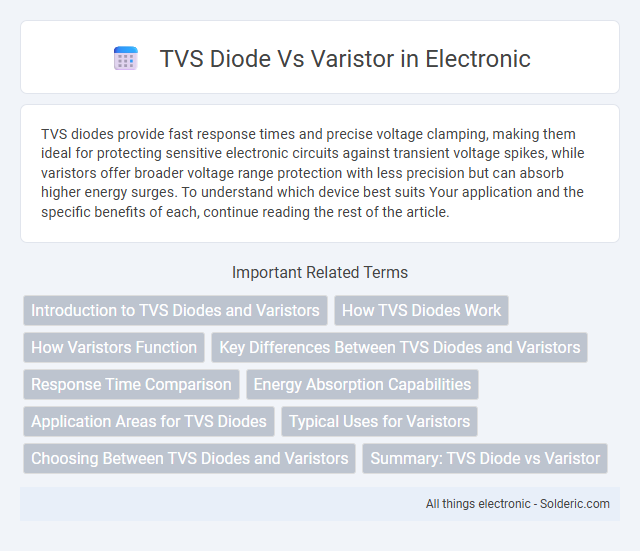TVS diodes provide fast response times and precise voltage clamping, making them ideal for protecting sensitive electronic circuits against transient voltage spikes, while varistors offer broader voltage range protection with less precision but can absorb higher energy surges. To understand which device best suits Your application and the specific benefits of each, continue reading the rest of the article.
Comparison Table
| Feature | TVS Diode | Varistor |
|---|---|---|
| Full Name | Transient Voltage Suppression Diode | Voltage Dependent Resistor (Varistor) |
| Function | Protects circuits from voltage spikes by clamping voltage | Absorbs and limits transient voltage by changing resistance |
| Response Time | Nanoseconds (very fast) | Microseconds (slower than TVS diode) |
| Voltage Clamping | Precise and stable voltage clamping | Less precise voltage clamping, depends on current |
| Energy Absorption | Lower energy absorption capacity | Higher energy absorption capacity |
| Common Applications | ESD protection, sensitive electronics, data lines | Power lines, surge protection in industrial equipment |
| Durability | Can wear out after repeated surges | Degrades after multiple surge events |
| Typical Package | SMT diodes, small signal packages | Disc or block-shaped components |
| Cost | Generally higher cost per unit | Generally lower cost per unit |
Introduction to TVS Diodes and Varistors
TVS diodes and varistors are essential components for protecting electronic circuits from voltage spikes and surges. TVS diodes respond with rapid, precise clamping voltage to transient events, making them ideal for sensitive low-voltage applications, while varistors provide broader voltage protection by changing resistance under surge conditions, suitable for higher energy transients. Understanding the distinct characteristics of TVS diodes versus varistors helps you select the appropriate device for reliable circuit protection.
How TVS Diodes Work
TVS diodes protect electronic circuits by clamping voltage spikes through rapid avalanche breakdown during transient overvoltage events. Unlike varistors that rely on non-linear resistance, TVS diodes react in nanoseconds, steering excessive current away from sensitive components to ground. Your devices benefit from this precise, reliable surge suppression, ensuring longevity and operational stability.
How Varistors Function
Varistors function by clamping voltage spikes through nonlinear resistance that changes with voltage, protecting circuits from transient surges. When voltage exceeds a certain threshold, the varistor's resistance drops dramatically, diverting excess current away from sensitive components. For Your circuit protection, varistors provide rapid and effective suppression of high-energy surges, distinct from the voltage clamping properties of TVS diodes.
Key Differences Between TVS Diodes and Varistors
TVS diodes provide rapid response time typically in the picosecond range, making them ideal for protecting sensitive electronic circuits from transient voltage spikes, whereas varistors respond in the microsecond range and are more suited for general surge protection in power lines. TVS diodes clamp voltage to a precise, defined level, ensuring minimal voltage overshoot, while varistors have a nonlinear resistance that changes with voltage, resulting in less precise voltage clamping. The durability of TVS diodes under repetitive surge events surpasses that of varistors, which tend to degrade over time due to energy absorption and thermal stress.
Response Time Comparison
TVS diodes offer response times typically in the picosecond to nanosecond range, making them ideal for protecting sensitive electronics from fast voltage transients. Varistors, on the other hand, have slower response times generally in the microsecond range, which can be insufficient for ultra-fast surge events. Choosing between the two depends on your need for ultra-rapid transient voltage suppression versus general surge protection.
Energy Absorption Capabilities
TVS diodes provide rapid response and precise clamping for transient voltage spikes, making them ideal for protecting sensitive electronic circuits with moderate energy absorption needs. Varistors excel in absorbing higher energy surges due to their bulk material properties, offering superior spike energy dissipation in industrial and power applications. Your choice depends on the specific energy absorption requirements and response time critical to your protection system's performance.
Application Areas for TVS Diodes
TVS diodes are widely used in protecting sensitive electronic circuits in automotive electronics, telecommunications equipment, and consumer electronics from transient voltage spikes and electrostatic discharge (ESD). Their fast response time and ability to clamp high-energy surges make them essential in power supply lines, data lines, and circuit boards within industrial automation and medical devices. Unlike varistors, TVS diodes provide precise voltage clamping and superior protection for low-voltage applications where repeated transient events occur.
Typical Uses for Varistors
Varistors are typically used for protecting electronic circuits against transient voltage spikes caused by lightning strikes, power surges, and switching events in power systems. They excel in absorbing large amounts of energy and are commonly found in power strips, surge protectors, and industrial equipment to prevent damage to sensitive components. Your devices benefit from varistors' ability to clamp high-voltage spikes, ensuring enhanced durability and reliable performance.
Choosing Between TVS Diodes and Varistors
Choosing between TVS diodes and varistors depends on the specific protection requirements for your electronic circuits. TVS diodes offer fast response times and precise voltage clamping, making them ideal for transient voltage spike suppression in sensitive devices. Varistors provide broader energy absorption capabilities and cost-effective protection against high-energy surges, suitable for general-purpose applications.
Summary: TVS Diode vs Varistor
TVS diodes provide fast clamping response times in the nanosecond range, ideal for protecting sensitive electronic circuits from transient voltage spikes. Varistors offer higher energy absorption capacity and are suited for handling large surge currents, making them effective in power line surge protection. Selecting between TVS diodes and varistors depends on application-specific requirements like response speed, energy handling, and circuit sensitivity.
TVS diode vs varistor Infographic

 solderic.com
solderic.com